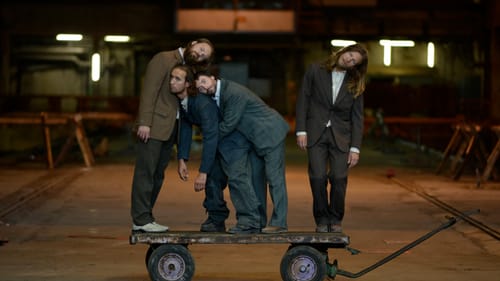Stay in the Loop
BSR publishes on a weekly schedule, with an email newsletter every Wednesday and Thursday morning. There’s no paywall, and subscribing is always free.
When nonsense makes complete sense
Fringe 2015: Jo Strømgren's 'Border' and 'There'

How does it happen that the most articulate pieces of political theater so far this season — and the most moving and insightful — are performed entirely in gibberish?
The talented Norwegian-based Jo Strømgren Kompani has returned to the Fringe Festival to give us two hour-long gems entitled The Border and There. The former deals with the dynamics of a relationship between a man and a woman; the latter is a piece about the existential angst of the refugee. Both are performed in completely fabricated languages. But that doesn’t matter — the messages and meanings come across loud and clear.
Mutual paranoia
The Border is an office romance performed in an empty space with only two desks and a set of moving partitions. “This is Harold’s office, and this is Harold,” a voice says over a loudspeaker, guiding us through an evolving relationship between two coworkers in a remote diplomatic outpost (in northern Norway, judging from the huge map projected on the upstage wall). Neither understands the other’s language, nor do we in the audience, since each speaks in gibberish. From the outset, they mistrust each other: She rifles through his papers, while he opens her outgoing mail and sets a bear trap under his desk to catch her sneaking photocopies of his work. As they dance their Kafkaesque pas de deux, their mutual paranoia increases, and they engage in a territorial power struggle that erupts into physical violence.
At the same time, they’re completely obsessed with each other. Once they find a single word whose meaning they both understand — “good” — they plunge into a passionate physical relationship. “Should they part?” the narrator asks toward the end. Performed entirely in dance and mime by the talented Ida Holten Worsøe and Ivar Sverrisson, The Border serves as a political parable for symbiotic relationships between nations, who also must struggle to learn how to coexist.
Waiting room
The second 60-minute piece, There, features four performers stranded in a no-man’s land between totalitarianism and freedom: in the aftermath of the Soviet Union’s dissolution, according to the program notes. Set in some kind of holding zone between countries (a warehouse, perhaps, or the hull of ship), these four are waiting, as for Godot. Will they be saved? Will they move forward into a new life, or will they return to the chaos of their homeland?

While they are waiting, they argue (in a kind of gibberish Sovietic language), they laugh, they listen to the radio, they pack and unpack crates, they dance to their favorite Russian songs (“Kalinka!” et al.), they play the sax and tuba, they weep with nostalgia. One man keeps trying to climb back into one of the crates that had borne them into freedom. Does the crate represent a coffin or a passage to a new existence?
In the end, they hear a train whistle — they’re on their way to a new life.
Strømgren and his amazing performers have shown us what can be accomplished in the theater in an hour, with no words at all.
Dance of brotherhood
With his stunning choreography, Strømgren and his company offer a deeply moving dance of brotherhood, support, and comfort: a more powerful message than any dialogue could articulate. Given the current migration crisis that has tens of thousands flooding Europe from North Africa and the Middle East, There, with its depiction of anguished refugees, couldn’t be more timely and more urgent.
The program includes a message for the audience: “The performers do not even know themselves what is being said on stage. So please do not panic.” You won’t. Indeed, you don’t have to speak any language at all to understand what the eloquent Jo Strømgren company is saying in these two new stage creations.
Since its inception in 1998, Strømgren’s talented Norwegian-based company has created 28 theater pieces; it tours 20 countries annually. Jo Strømgren’s "gibberish" has been heard and understood by people of many nations, thanks to the unique brand of humor and style that he and his gifted company have developed — an eclectic, virtuosic blend of commedia dell’arte, vaudeville, slapstick, mime, and acrobatic ballet. It's an international language that needs no translation.
For a review of the Jo Strømgren Kompani’s Fringe production of A Doll’s House, click here.
What, When, Where
The Border and There, performed by the Jo Strømgren Kompani. September 9-12 at the FringeArts Theatre, 140 North Columbus Boulevard, Philadelphia. Part of the 2015 Fringe Festival. FringeArts.com or 215-413-1318.
Sign up for our newsletter
All of the week's new articles, all in one place. Sign up for the free weekly BSR newsletters, and don't miss a conversation.
